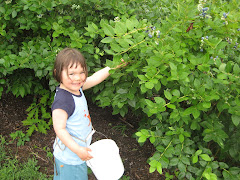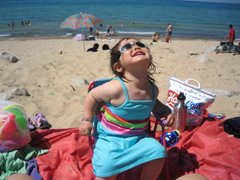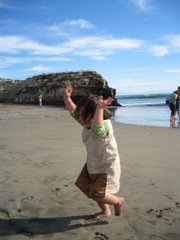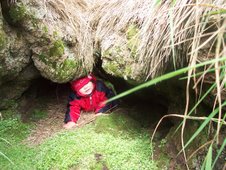The longer I live here, the more it becomes part of my rhythm, too, that I change my habits and behavior depending on the season. It just feels natural, now, that we yuraq (traditional dance) in the winter, and it would feel a bit off if we danced, now. My body responds to the growing light, as well, and I begin to have so much more energy, so much more desire to get a whole bunch of things done when the light stays for so much of the day (Right now, the sun sets somewhere around 12:30 am and gets light around 3.... as far as I can tell. I'm mostly asleep at those times, so I miss all the dark! It will only get more intense, since we have a month until the solstice). Anyway, I find myself hankering after spring activities, also, wanting to be out on the tundra, wanting to be out on the water. I see waterfowl flying above and I get a taste in my mouth for that rich, fatty skin.... I like that I'm acclimated to living here, not just mentally but in body, too.
So soon after we started seeing little snowbirds flying in flocks around the tundra, the ptarmigans began to go close to town, and when people were ptarmigan hunting, they began to see ducks, geese, and other migrating birds coming back. The ducks and geese are mostly what hunters take, and there are some species that are closed for hunting, but occasionally a hunter will take a swan or a crane, as well.
My favorite shorebirds are the arctic terns, as they are the longest migrators -- I think they fly pole to pole. Their wings are so long, thin, and arched.... they are amazing. They have a double-pointed feather tail, and their cry is so interesting. They say, "Kee-aarrrr", with a really gutteral almost-growl at the end. I also love the snipes (yes, there really are snipes, those of you who are victims of the infamous joke-snipe-hunting), because they fly really high into the air and dive, and the wind over their wings makes a haunting hooting sound. I first heard that sound when I was in Scotland, on a wonderful night at the standing stones called Calanais on the Isle of Lewis, and my friend and traveling companion Tanja and I thought they must be some kind of spirit. Even though I know better, now, I still feel a rush and thrill of other-worldliness when I hear the hooting of the snipes diving.
 Snipes swimming on a pond, picking off little waterbugs.
Snipes swimming on a pond, picking off little waterbugs.Tundra swallows visited us, as well, for a few sunny days, and roosted all over our porch. They were amazingly brave, not shy of our movements inside the house at all, and Esther could watch and talk to them through the window without them flying away. In fact, one day we opened the door to our porch and there were five of them basking in the sun, and they were so slow to fly away that Esther almost was able to pet one. They are such beautiful black and iridescent blue swallows, sweet birds. Local lore says they bring luck to us when they roost on our house, so I guess we have been blessed with a lot of luck!
Roy went hunting for waterfowl for many days in a row, and he brought home a bunch of birds, mostly white-fronted geese. After my experience last year plucking, I had made a vow to myself that I would pluck the geese the day he brought them home, because they are so much easier to pluck the first day, before the skin starts to hold the feathers fast. I guess before I tried plucking them, I never thought about how much work and skill is involved in plucking and doing a good job of it. Fingertips get sore, and wrist and palm muscles get tired, especially if there are many to do at once. The first night, when Roy brought home 4, I plucked a few and put a few in the freezer whole, on the advice that they will last longer without getting freezer-burned into next year if they are whole. But I wonder what it will be like plucking birds that have been frozen?
After that first night, when I plucked them inside our arctic entryway porch and inhaled a whole bunch of floating down, I decided that the next time, I would pluck them outside. I called around to community people I trust, and asked them if it was considered OK to pluck birds outside, and they said I could do it if I was out a little bit from town and the wind was blowing the feathers away from town. The next time Roy brought home 3 geese, and Esther, fellow-teacher Holly and I started out with the birds in a gunny sack for the side of the school next to the bay. It was a great experience! The tundra is so soft and accommodating to sit on for long periods of time, and the wind blowing the feathers away is great. I found that I had to sit a little cross-ways of the wind, not with my back to the wind, or my body would create an eddy in which the feathers would fly right back into my face! The only downside is that my fingers got cold and therefore tired faster. But I have found that doing the bulk of it at once is a good plan, and then doing the fine, little work of plucking the head, wings, and smaller feathers can be done later, when getting them ready to cook. 

Here is my teaching comrade Holly plucking her first goose; we are outside behind the school. The picture below is all the feathers from the geese we plucked that evening, when we were all done.
One Friday evening, the night of graduation, I went straight from the ceremony to my favorite bird-plucking spot, and several students came to check me out. They ended up helping me pluck, just for the fun of it, and I was so glad to have their help because it had started to get cold. Mists were rolling in from the ocean, and the air was just heavy with its chill. There were swans swimming, so elegantly, on little ponds near us, and their white feathers stood out even through the mist. It was such a beautiful sight, they were nearly ghost-like, sliding across the ponds through the mist.
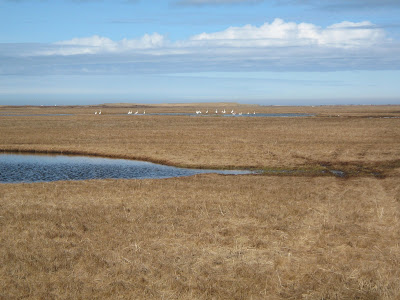
A flock of swans out on the tundra -- they're far away, so even though the picture is little, you can tell how big they are!
When Roy brought home the most birds at one time, 13 in one day(total I think he caught 25 birds this spring), I had a lot of work in front of me. We gave some away to relatives, and then put some in the freezer, but I still needed to work on several that afternoon. It was a sunny Sunday, and Esther wanted to go out with me, so we walked with the birds to behind the school, where the bay is a few hundred yards away. There were several ponds in between the hills where I was sitting and where the bay began, and birds were alighting in the ponds here and there. There was no danger of Esther walking all the way to the bay, but I let her wander and play around near me; there was lots of driftwood for her to climb on, and dirt for her to dig in, etc. A pair of swans alighted in the pond nearest to us, and she noticed them right away. She marched right up to the pond's edge and hollered, "Nice a meet you, swans!". So precious. When I think of what she is possibly missing out of city life, such as swimming lessons or kids' orchestra concerts or some kind of preschool, I feel badly about it, but then I think, "what city child has the chance to experience these things, and to interact so closely with such a wild environment?" and I think it just has to be OK.
Coming soon will be our adventures in egg hunting... I can't wait!





















 Here are Jasmine, Esther, Avery, and Alex -- Jasmine and Avery are her cousins and Alex is her uncle, Roy's youngest brother.
Here are Jasmine, Esther, Avery, and Alex -- Jasmine and Avery are her cousins and Alex is her uncle, Roy's youngest brother.

 Big Guy: Odin Jade in early May -- he's such a quirky dog, always crossing his legs!
Big Guy: Odin Jade in early May -- he's such a quirky dog, always crossing his legs!


































